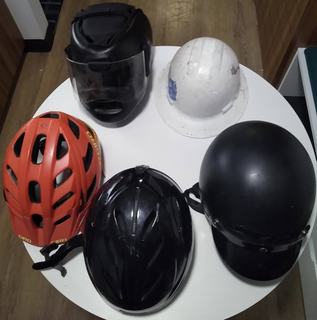 W
WA helmet is a form of protective gear worn to protect the head. More specifically, a helmet complements the skull in protecting the human brain. Ceremonial or symbolic helmets without protective function are sometimes worn. Soldiers wear helmets, often made from lightweight plastic materials.
 W
WThe American fiber helmet is a type of sun helmet made of pressed fiber material that has been used as part of the military uniform by various parts of the United States Armed Forces, from 1934 to present. As of 2017, the helmet continues to be worn by US military rifle range cadres, as an icon for marksmanship excellence. The helmet is technically not a pith helmet, insofar as it is not constructed from pith material. However, in the more generic sense of design style, this type of sun helmet is modeled similarly to one and thus often referred to in common use as a pith helmet. Additionally, the helmet is not a combat helmet, insofar as it was not originally designed to protect the head during combat. However, the helmet was nonetheless assigned, at various times in the 1930s and 1940s, as combat gear for use in active theaters.
 W
WA baby bumper headguard cap, also known as a falling cap, or pudding hat, is a protective hat worn by children learning to walk, to protect their heads in case of falls.
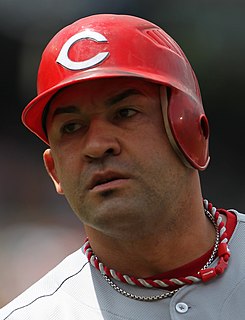 W
WA batting helmet is worn by batters in the game of baseball or softball. It is meant to protect the batter's head from errant pitches thrown by the pitcher. A batter who is "hit by pitch," due to an inadvertent wild pitch or a pitcher's purposeful attempt to hit him or her, may be seriously, even fatally, injured.
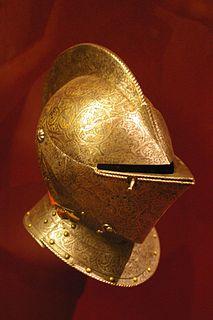 W
WThe close helmet or close helm is a type of military helmet that was worn by knights and other men-at-arms in the Late Medieval and Renaissance eras. It was also used by some heavily armoured, pistol-armed, cuirassiers into the mid 17th century. It is a fully enclosing helmet with a pivoting visor and integral bevor.
 W
WHelmets in cricket were developed in the 20th century.
 W
WThe custodian helmet is the modern name applied to the helmet worn by male police officers in England and Wales and certain other places around the world.
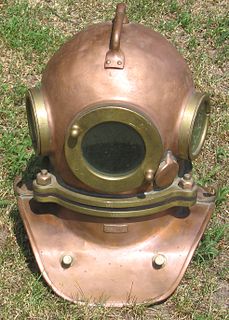 W
WA diving helmet is a rigid head enclosure with a breathing gas supply used in underwater diving. They are worn mainly by professional divers engaged in surface-supplied diving, though some models can be used with scuba equipment. The upper part of the helmet, known colloquially as the hat or bonnet, may be secured to the diver or diving suit by a lower part, known as a neck dam, breastplate, or corselet, depending on the construction and regional language preferences.
 W
WAn equestrian helmet is a form of protective headgear worn when riding horses. This type of helmet is specially designed to protect the rider’s head in the event of falls from a horse, especially from striking a hard object while falling or being accidentally struck in the head by a horse’s hoof.
 W
WAn eyeshield is a piece of football equipment that is also referred to as a visor that was created in the 1980s. In the mid 1900s as an effort to prevent brain and head injuries, headgear became mandatory in the game of football. was created to protect the eyes of football players during games and practices. It is a curved piece of plastic that attaches to the front of a football helmet. Safety equipment such as the facemask, eyeshields, and other face shields have been adopted over time to prevent player injury. The eyeshield leaves the mouth exposed, but covers the eyes and nose. The piece of equipment is made from various materials and by many different brands. Only clear eyeshield's are permitted for use in high school football games due to the fact that eyes are needed to be seen while checking for a concussion. For college level players, the eyeshield may be tinted for players with eye problems.
 W
WFor centuries, firefighters have worn helmets to protect them from heat, cinders and falling objects. Although the shape of most fire helmets has changed little over the years, their composition has evolved from traditional leather to metals, to composite helmets constructed of lightweight polymers and other plastics.
 W
WA flight helmet, sometimes referred to as a "bone dome" or "foam dome", is a special type of helmet primarily worn by military aircrew.
 W
WThe football helmet is a piece of protective equipment used mainly in gridiron football. It consists of a hard plastic shell with thick padding on the inside, a face mask made of one or more plastic-coated metal bars, and a chinstrap. Each position has a different type of face mask to balance protection and visibility, and some players add polycarbonate visors to their helmets, which are used to protect their eyes from glare and impacts. Helmets are a requirement at all levels of organized football, except for non-tackle variations such as flag football. Although they are protective, players can and do still suffer head injuries such as concussions.
 W
WA hard hat is a type of helmet predominantly used in workplace environments such as industrial or construction sites to protect the head from injury due to falling objects, impact with other objects, debris, rain, and electric shock. Suspension bands inside the helmet spread the helmet's weight and the force of any impact over the top of the head. A suspension also provides space of approximately 30 mm between the helmet's shell and the wearer's head, so that if an object strikes the shell, the impact is less likely to be transmitted directly to the skull. Some helmet shells have a mid-line reinforcement ridge to improve impact resistance. The rock climbing helmet fulfills a very similar role in a different context and has a very similar design.
 W
WIn heraldic achievements, the helmet or helm is situated above the shield and bears the torse and crest. The style of helmet displayed varies according to rank and social status, and these styles developed over time, in step with the development of actual military helmets. In some traditions, especially German and Nordic heraldry, two or three helmets may be used in a single achievement of arms, each representing a fief to which the bearer has a right. For this reason, the helmets and crests in German and Nordic arms are considered to be essential to the coat of arms and are never separated from it.
 W
WHelmet of eight plates in the Korean style is a helmet produced between 14th and 16th centuries in either Korean peninsula or Mongolia. This helmet consists of eight plates made of iron. It is speculated that this helmet style was spread to Korean peninsula from the Tibetan regions. Helmets with similar structure can be seen in Tibet, while both versions of the helmet are made of iron and leather. But Korean-style eight plated helmets are distinguished from those of Tibetan style by its relatively smaller size. Usually a Tibetan-style eight plated helmet measures 21–22 cm in height. But this Korean style helmet measures only 13 cm in height. Currently displayed at the Metropolitan Museum of Art, New York, the Korean style helmet measures 24.3 cm in length and 21 cm in width and 1065.9 g in weight.
 W
WA hockey helmet is worn by players of ice hockey, inline hockey, and bandy to help protect the head from potential injury when hit by the puck, sticks, skates, boards, other players, or the ice. The shell of a hockey helmet is generally made of a substance called vinyl nitrile that disperses force from the point of contact, while the liner may be made of either vinyl nitrile foam, expanded polypropylene foam, or other material to absorb the energy, to reduce the chances of concussion. Hockey helmets grip the head from inside by cupping the back of head, or the occipital protuberance. Helmet manufacturers will have a chart that relates their helmet sizes to head measurements. Mt on older models, the helmet size is adjusted by loosening the screws on the side to slide the front portion forward or back.
 W
WJolt Sensor, founded in 2014 by two MIT graduates, is a company that produces wearable concussion sensors which aim to mitigate head injuries in athletes. These devices can be paired with electronic devices, such as a smartphone or laptop, and send data on impact sustained by the wearer of the sensor. The data can evaluate whether the impact was serious enough to induce a concussion.
 W
WA lacrosse helmet is a protective headpiece worn primarily in men's lacrosse, but also worn optionally by women's lacrosse players in Australia. Modern helmets consist of a hard plastic, non-adjustable shell with thick padding on the inside, a face mask made of metal bars, and a chinstrap used to secure the helmet to the head. Some players also attach a sun visor shielding the eyes, though these visors are not legal in most leagues.
 W
WDuring the first years of aviation pilots started wearing leather flying helmets as a form of protection from the cold and the noise of aircraft engines. Leather was becoming a popular choice for protective gear with the rise of motor sport and aviation at the start of the 1900s. It has many advantages that made it the ideal material for flying helmets. It is warm, durable, impermeable to liquids therefore waterproof, flexible and can be cut to curve around the head. It is wind-proof and has the great advantage of not accumulating dust. It was also found that leather helmets offered a level of protection against fire. British Engineers lead by Charles Edmond Prince added Throat microphones & earphones into these helmets during World War I for hands free communications in the noisy and windy environment of aircraft cockpits.
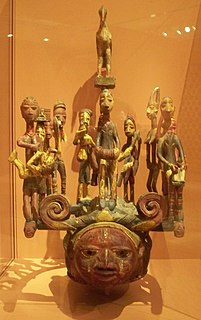 W
WThis Magbo helmet mask for an Oro society member was created by Yoruba artist Onabanjo of Itu Meko. It is currently located in the African collection of the Indianapolis Museum of Art, which is in Indianapolis, Indiana. Created around 1880-1910, it depicts a varied cast of community members carved of wood, colored with pigment, and mounted on a curved bar surmounting the helmet.
 W
WHawaiian feather helmets, known as mahiole in the Hawaiian language, were worn with feather cloaks. These were symbols of the highest rank reserved for the men of the aliʻi, the chiefly class of Hawaii. There are examples of this traditional headgear in museums around the world. At least sixteen of these helmets were collected during the voyages of Captain Cook. These helmets are made from a woven frame structure decorated with bird feathers and are examples of fine featherwork techniques. One of these helmets was included in a painting of Cook's death by Johann Zoffany.
 W
WA motorcycle helmet is a type of helmet used by motorcycle riders. Motorcycle helmets contribute to motorcycle safety by protecting the rider's head in the event of an impact. They reduce the risk of head injury by 69% and the risk of death by 42%. Their use is required by law in many countries.
 W
WMIPS BPS is a safety technology for helmets. In the event of an angled impact MIPS can reduce harmful rotational forces, which may be transmitted to the brain, by allowing the helmet to slide relative to the head. These rotational forces can cause concussions or even worse brain damage. MIPS stands for Multi-directional Impact Protection System.
 W
WThe pith helmet also known as the safari helmet, sun helmet, topee, sola topee, topi, or salacot, is a lightweight cloth-covered helmet made of sholapith. The pith helmet is an adaptation of the native salakot headgear of the Philippines.
 W
WA racing helmet is a form of protective headgear worn by racing car and rally drivers. Motor racing has long been known to be an exceptionally risky sport: sudden deceleration forces on the head can easily occur if a racing car loses control at the very high speeds of competitive motor racing or the rough terrain experienced in rallying. A risk more nearly unique to motor racing is the possibility of drastically severe burns from fuel igniting when the fuel lines or fuel tank of the vehicle are jolted sufficiently to dislodge or breach them in a situation in which the driver cannot soon enough escape from his car. This happened to world champion driver Niki Lauda at the 1976 German Grand Prix race at the Nürburgring in a crash from which he barely escaped alive.
 W
WA riot protection helmet is a type of helmet designed for law enforcement and military use to protect its wearer's head, face and eyes from handheld melee weapons, and thrown projectiles such as bricks, as may be met in riot control. Many modern riot squad helmets are reinforced with materials that will protect the wearer from dangerous substances such as acids or industrial chemicals. The riot protection helmets are usually made to be able to easily fit a Gas mask, especially when tear gas is being used.
 W
WSHARP is a British government quality ratings scheme for motorcycle helmets, established in 2007, with the objective of improving motorcycle safety on UK roads.
 W
WShield-X Technology Inc. is a developer and manufacturer of impact-diverting technology. Shield-X's decal, is designed to enhance helmet performance in contact sports and activities where traumatic brain injury (TBI) such as concussions occur, including American Football, Ice Hockey, and Cycling.
 W
WA shock detector or impact monitor is a device which indicates whether a physical shock or impact has occurred. These usually have a binary output (go/no-go) and are sometimes called shock overload devices. Shock detectors can be used on shipments of fragile valuable items to indicate whether a potentially damaging drop or impact may have occurred. They are also used in sports helmets to help estimate if a dangerous impact may have occurred.
 W
WA ski helmet is a helmet specifically designed and constructed for winter sports. Use was rare until about 2000, but by about 2010 the great majority of skiers and snowboarders in the US and Europe wear helmets. Helmets are available in many styles, and typically consist of a hard plastic/resin shell with inner padding. Modern ski helmets may include many additional features such as vents, earmuffs, headphones, goggle mounts, and camera mounts.
 W
WThe Snell Memorial Foundation is a nonprofit organization created to provide a high quality standard of safety for helmets. Founded in 1957, the foundation is named after William "Pete" Snell, a popular sports car racer who died in 1956 of head injuries he received when the racing helmet he wore failed to protect his head. A group of friends, scientists, physicians, and others joined together to create a group that would promote research and education as well as test and develop standards to improve the effectiveness of helmets.
 W
WTarnhelm is a magic helmet in Richard Wagner's Der Ring des Nibelungen. It was crafted by Mime at the demand of his brother Alberich. It is used as a cloak of invisibility by Alberich in Das Rheingold. It also allows one to change one's form:Alberich changes to a dragon and then a toad in Das Rheingold, Scene 3. Fafner changes to a dragon at the end of Das Rheingold and appears thus in Siegfried Act II. Siegfried changes to Gunther's form in Götterdämmerung Act I, Scene 3.
 W
WA winged helmet is a helmet decorated with wings, usually on both sides. Ancient depictions of the god Hermes, Mercury and of Roma depict them wearing winged helmets, however, in the 19th century the winged helmet became widely used to depict the Celts. It was also used in romantic illustrations of legendary Norse gods and heroes. The motif, along with the horned helmet, became a clichéd signifier of the Northern warrior.